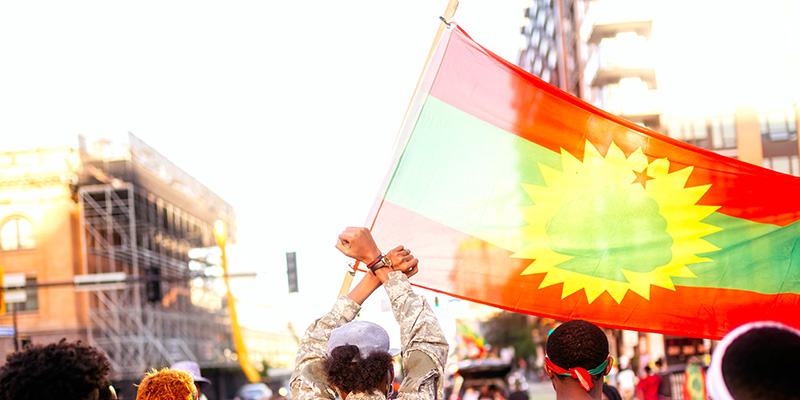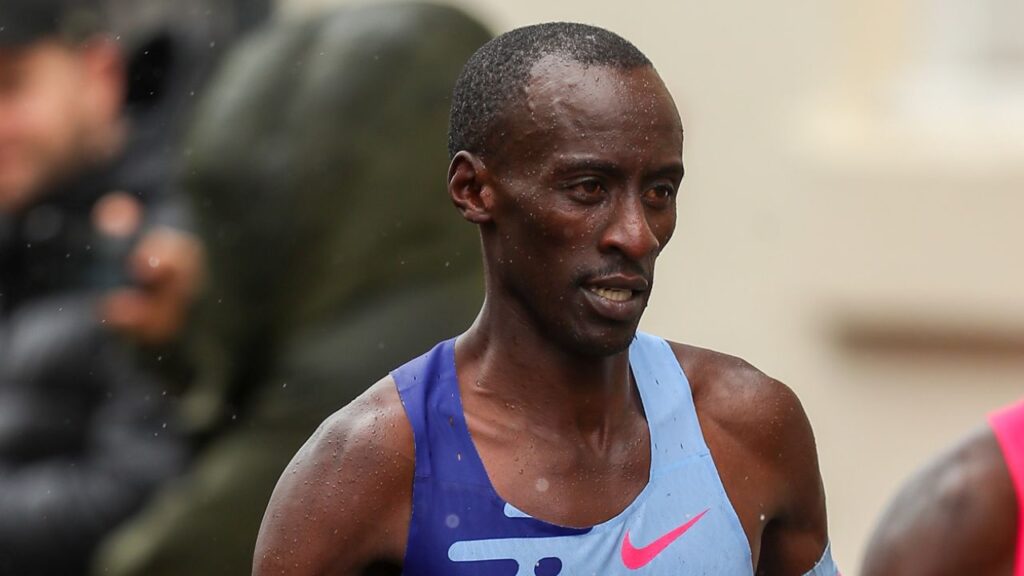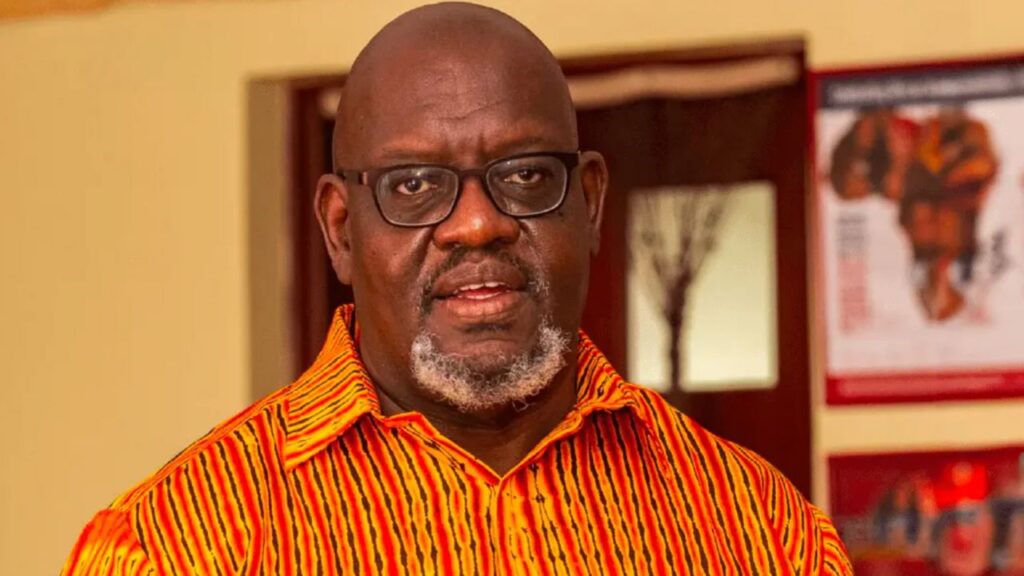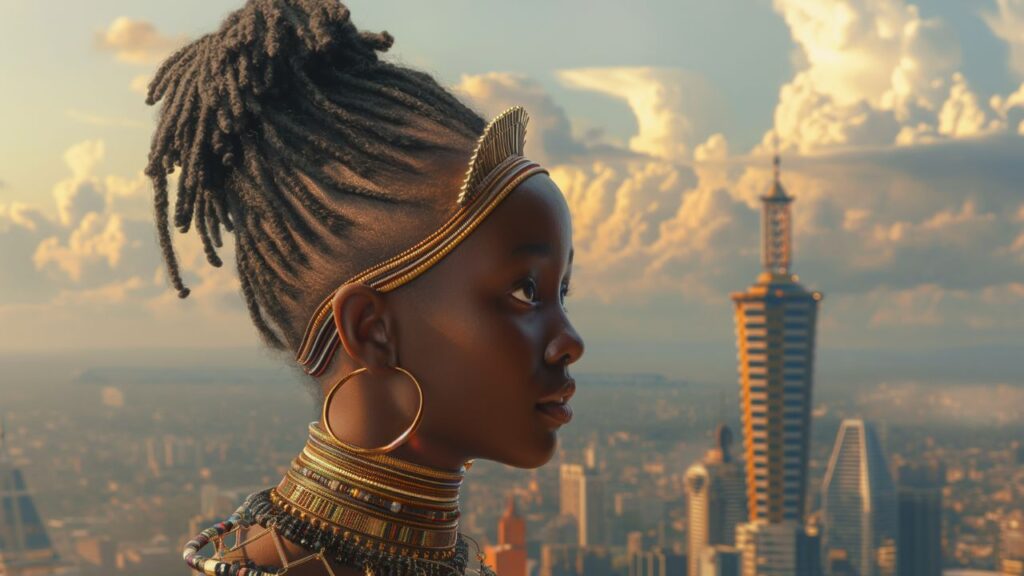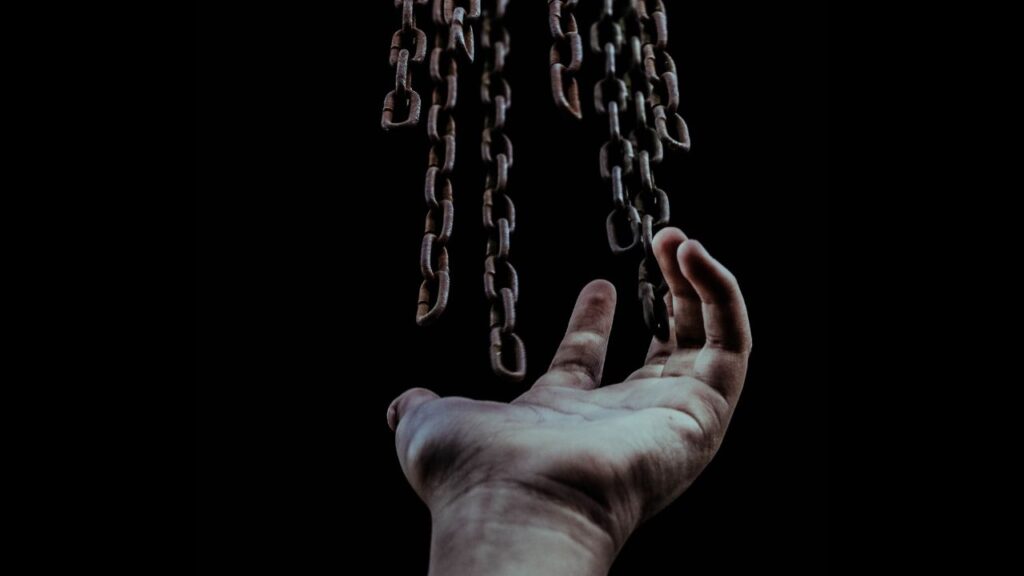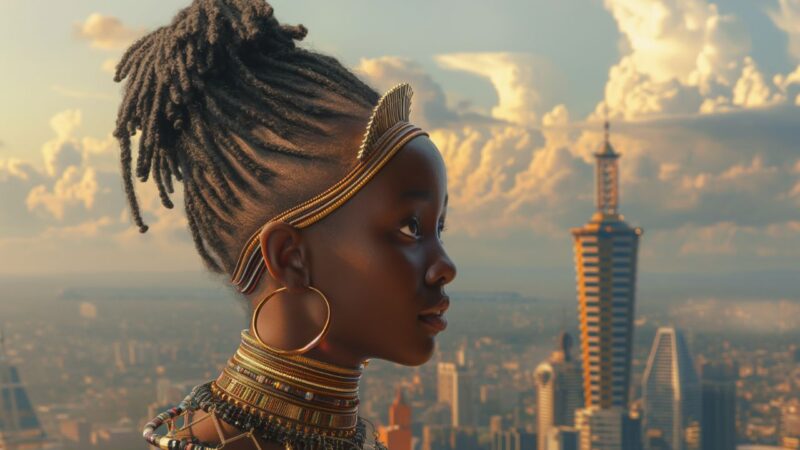A Kenyan Journalist was arrested in Addis Ababa in the wake of the assassination of Haacaaluu Hundeessaa, a popular Oromo musician. Yassin Juma was arrested alongside prominent Oromo opposition political figures like Jawar Mohammed, the founder of the Oromo Media Network. Juma was later charged with “incitement and involvement in violence, plotting to create ethnic violence and plotting to kill senior Ethiopian officials”.
A court freed him but the police continued to hold him.
Yassin Juma is perhaps the only Kenyan journalist to show interest in the Oromo liberation movement. In Kenya, both the media and government functionaries view the Oromo Liberation Front (OLF) as a security threat, with journalists rehashing half-baked arguments about what the OLF means in the region’s conflict.
It was Yassin Juma who introduced the Oromo cause to a larger Kenyan audience with his TV documentary, Inside Rebel Territory, 10 years ago. In it we follow Yassin as he goes in search of OLF fighters: “It was a journey that finally yielded [the] faces of one of Africa’s longest albeit low-key rebellions . . . the OLF was for decades a mystery”.
Inside Rebel Territory earned him the respect of the Oromo and the ire of Meles Zenawi’s regime. Five months ago he was invited to Finfinnee Radio’s 5nan Show where he spoke about the state of the media and reflected on his coverage of the Oromo movement.
My reason for being here is to make a follow-up documentary to [. . .] Inside Rebel Territory . . . I am doing a documentary about the rebels I met then, their life now, after Dr Abiy took over [as Ethiopia’s prime minister] . . . how they find life and so forth.
We can already guess what the new Ethiopia looks like. Guracho, who featured in Yassin’s documentary, is now in jail. Falimatu, a woman he had interviewed, may have been killed two or three years ago. He was in Addis Ababa when Haacaaluu Hundeessaa was killed and the country erupted into violence. Ethiopia prefers to hide its face from the roving cameras of the likes of Yassin Juma.
On Finfinne Radio Yassin reveals who he is, how the story he had done on the OLF was almost killed. How he was offered $150,000 by the Zenawi regime to kill it. How he had received threats. How the owners of Nation Media Group had not been happy with that coverage. How it had caused a diplomatic row between Kenya and Ethiopia. How it triggered a series of events that eventually led to his leaving NTV. How since then his life and that of his family has not been very secure: “In 2009 I was almost shot dead twice in front of my house . . . In 2016 I had to move to Uganda for three months for helping to organise Oromo protests in Kenya”. He was officially banned from entering Ethiopia.
Yassin Juma had covered the Oromo Liberation Front at a time when the movement badly needed the coverage. Ethiopia’s notorious media laws, stemming from the US-backed antiterrorism law, had forced its outspoken journalists into prison. That coverage was important on many counts; it came out at a time when the Oromo cause was transitioning from armed rebellion to an ideological youth- and artists-led movement at around the same time that Haacaaluu was breaking onto the music scene. A scroll through Yassin Juma’s Facebook page shows how important a player he had become in the Oromo cause; he is seen posing with Jawar and Haacaaluu and appears in most Oromo events held in post-revolution Ethiopia.
Kenya, Ethiopia and the Oromo question
For Kenya, Ethiopia is a landlocked market of 100 million people, a destination for goods from its ports and, more recently, a partner in the LAPSSET (Lamu Port, South Sudan, Ethiopia Transport) corridor project. In this context, complex stories such as Yassin Juma sought to tell were to Kenya an unwelcome initiative, going against sixty years of close cooperation built around keeping Somalia’s aggression in check. For their part, both the OLF and successive Ethiopian regimes have recognised the strategic importance of Kenya.
As an immediate neighbour, Kenya was important for the Oromo cause—as a refuge for thousands of fleeing Oromos and as transit territory for Oromos escaping oppression at home. Kenya’s importance in the Horn’s geo-politics, it’s appeal as a regional “bastion of peace” and as the regional capital for all manner of international media outlets and posh western think tanks, as well as Kenya’s role in Somalia’s pacification efforts and its shuttle diplomacy in South Sudan’s independence, have fuelled the Oromos’ desire to secure Kenya as an important ally. But how Kenya perceived and portrayed the Oromo struggle spoke volumes about the liberation movement’s international image.
In Kenya, the roots of the OLF rebellion were whitewashed and a truncated history was often told, the Oromo liberation struggle being portrayed as a threat to regional peace. The Kenyan media has reduced the OLF in the Kenyan mindset to illegitimate militias out to destabilise the region. Ethiopian ambassadors have reinforced the local political and media narrative that the Oromo cause is a quest to establish an Oromo super-state stretching all the way to Tana River, a narrative intertwined with other stories about the skirmishes between the Gabra and Borana in Marsabit. The OLF thus became the regional insecurity scapegoat, blamed for the October 1998 Bagalla Massacre in which 140 people were killed in Wajir and the July 2005 Turbi Massacre in Marsabit in which almost 90 people perished, and for the proliferation of arms in the north, for banditry, and even for livestock rustling.
Yet, this conclusion glossed over the complexities at play; the Ethiopian army’s harassment of Kenyans at the border was either ignored or the frequent abductions, killings and harassment of Kenyans by the Ethiopian military were dismissed as being the work of locals.
Following the Turbi Massacre, the OLF’s Dr Fido Ebba said that the OLF’s image was wrongly tainted and that the problem in Marsabit is two-fold, some of the raids are purely tribal. They pit civilian communities against each other over scarce resources and cattle. The rest are diversionary tactics by militias engaged by authorities within Ethiopia’s ruling class. They aim at inciting communities on the Kenyan side and possibly the government into fighting the OLF back.
Ethiopia also issued a similar counter-argument, for example in April 2006, when the OLF was blamed for the killing of two herders in Dukana. Ethiopia’s then acting ambassador to Kenya, Mr Ajebe Ligaba Wolde, insisted that it is the OLF that provokes and incites people along the border with Kenya. “They [OLF] put on Ethiopian soldiers’ uniforms to defame Ethiopia . . . OLF is not only a threat to peace in Ethiopia, but also to Kenya and the whole region. They want to destabilise the region”, said Mr Wolde.
Oromo Liberation Front ideologues and leadership view Kenya as an important player to whom they look with hope, believing that peace will come sooner if Kenya steers the talks between the Oromo and Ethiopia. “If Kenyans mediated between the Ethiopian government and the Oromo they would understand the problems better, just like they did with Sudan and Somalia”, said Dr Fido Ebba.
Ethiopia, which contributed to the liberation of Kenya’s struggle for independence (and was gifted an embassy in appreciation), has enjoyed a long, peaceful diplomatic relationship with Kenya, having signed a defense pact and a treaty of friendship and cooperation in the 1980s. Dr Fido Ebba wishes that the OLF could have its administrative base in Kenya, and not in the US (Washington) as is currently the case. “Our push for liberation would then be coordinated from close proximity”, he says.
Incursions into Kenyan territory by the Ethiopian army in search of the OLF are very common. In 2015 the Ethiopian army crossed into Kenya six times, once even taking over a police station in Illeret, Marsabit. Cross-border massacres—like the March 1997 Kokai Massacre in which 80 people including 19 police officers were killed—have been raised with the Ethiopian regime.
The OLF pointed an accusing finger at the Kenyan government and army, claiming that the Kenyan army has supported the Ethiopian army to wage war against the OLF, that Kenya had broken with several international protocols to abduct and repatriate legitimate Oromo refugees and that Oromo activists have been assassinated by Ethiopian security agents on Kenyan soil.
The decades-long struggle and the fraught relationship between Kenya, the OLF and Ethiopia seemed for a brief moment to be water under the bridge when the Oromo Media Network (OMN) was launched in Nairobi in the wake of the Qeerroo revolution. During the launch, Jawar Mohammed said:
I have come to this place many times before. I had to change my name and look. I am happy that we now can reveal our names and faces to each other. We didn’t plead for this . . . We fought for it . . . We threw those who made us hide our faces in a hole and came out . . . It’s not play that brought us here . . . We lost people like Jatani Ali to arrive here . . . I would like to say thank you to the government of Kenya even though they were not open and fully supportive of our struggle . . . There cannot be liberation for Oromos or for Ethiopia without its neighbours.
Mohammed spoke of how the OMN would lead to the establishment of a bridge between the two countries by bringing the Oromos in Kenya together and by connecting the Oromos in Kenya with the Oromos in Ethiopia through listening to the OMN.
In the constructed narrative, this talk could easily be misconstrued as alluding to the establishment of an Oromia republic stretching into Kenya.
The Oromos of northern Kenya
When Dr Abiy Ahmed became the Ethiopian premier, there were celebrations in Nairobi and in the streets of Isiolo, and a commemoration for all the slain Oromo people was held in Marsabit.
The Marsabit County Woman Representative, Safia Sheikh Adan, organised a memorial day for slain Borana heros and waxed lyrical about the Oromo liberation—Bilisumna—weeping as she recited a poem and read the names of leaders slain through political machinations.
But one name was repeated again and again by Governor Mohammed Ali, by Jawar Mohammed and by the Woman Representative. Mebastion Jatani Ali Tandhu, the former Provincial Governor of Borana Province in Southern Oromia who was assassinated by Ethiopian security agents on 2 July 1992 at Tea Zone Hotel in Nairobi. Jatani Ali Tandhu had been in Kenya to seek political asylum from Zenawi’s Ethiopia. Over the past three decades, he has become an Oromo political liberation martyr and cultural icon, his words revisited in songs and Oromo protest poetry. In commemoration, a message was carried in Kenya’s Daily Nation on the 10th anniversary of his death: “Exactly 10 years since you were brutally murdered by the operatives of Tigre Peoples Revolutionary Front (TPLF)/Ethiopian People’s Revolutionary “Democratic” Front (EPRDF). The course for which you died is still alive”. With Abiy in power, his glory was resurrected and an equestrian statue was installed in the centre of his hometown of Yaballo. New songs were composed in his praise. Jatani Ali Tandhu had been buried in Marsabit and when Abiy came to power, his grave at the Marsabit cemetery was repainted.
It was Safia Sheikh Adan who financed the commemoration day. She spoke about Jattani Ali Tandhu’s contributions and mentioned other prisoners like Jatani Kunu who she said was still being held in an underground prison in Ethiopia. “We have lost many brave and strong people . . . Jatani Ali Tandhu, Galo Wolde, Qala Waqo, Sheikh Hassan, Hussein Sora Agole, Mohammed Halakhe Fayo and Hersi Jatani”.
In her overly sentimental tributes, Safia Sheikh Adan mentioned the names of slain former Kenyan parliamentarians like Guyo Halakhe, Philip Galma and Isacko Umuro. Their assassinations, like that of Daudi Dabasso Wabera (the first African Colonial District Commissioner who was assassinated by the Shifta in 1963), were unrelated to anything Oromo.
But the poem Safia Sheikh Adan recited, her tears and her actions were out of sync with the local politics and current feeling. A few understood her but most people watched her and wondered where her emotions were coming from and her efforts were finally without significance or consequence, dismissed as part of the initial euphoric joy that an Oromo was finally the Ethiopian premier.
Marsabit, music and protest poetry
When popular musician Haacaaluu Hundeessaa was killed on 29 June 2020, our hearts were broken and the sense of grief that engulfed us had a familiar weight. As Ethiopia descended into mourning and chaos, in Marsabit I listened to Haacaaluu’s albums anew. My friend and I paused and replayed certain songs to try to decipher what he meant and our sadness was deepened by the raw honesty of the injustice he described. That this was the soundtrack of a now stolen revolution added to the feeling that Ethiopia was a place of great injustice.
I remembered the image of Haacaaluu bursting onto the music scene about 10 years ago, a skinny boy in oversized shirt and trousers. We spoke about his music and his political education, his 5-year jail term when he was just 17 years old. We revisited the words of the Oromo liberation struggle as if we were reminiscing, as if it was about us. And we said aaaayyyiii, expressing the turmoil in our hearts. But at the end of the day, none of the political pathos and calls to action were about us, and nor were they happening on our doorstep. The deep articulation of the injustice that we listened to was in our own language but that struggle was not ours.
The aftermath of Haacaaluu’s death and the blowback in Oromia leads me to thoughts about what the Oromo struggle means to those of us who have come of age under its shadow.
To grow up in a liminal space like Marsabit is to be in an endless interregnum of something not quite yours. The earliest memory of the Oromo liberation struggle for me dates back to when I was six years old in mid-1990s Marsabit. Back then, a tape of a poet would be shared across the town, and we would listen alongside our parents, picking up words that sounded funny and made no sense to us.
It was hard, then, to link those words to concepts like oppression and injustice. But over the years, the OLF became the subject of whispers in Marsabit. OLF stories circulated in the manner of a secret; tales of disappearances were told, of men whose wives were taken in the night, of people whose lips had been cut off for snitching. The whisper was a mix of many fears, of the Kenyan Special Branch, of District Commissioners who had lists of OLF sympathisers, of the OLF itself, of Ethiopian spies. In Marsabit some of the murders in the town were linked to these fears.
In our home, the land of our grandparents’ past, Ethiopia, was the unspoken and unacknowledged thought. But its music was the future we aspired to; our heartbreak, our love, our longing for elusive dreams were in those lyrics.
Once, my dad came home with a small OLF flag, with the tree in the middle and the star above it. He stuck it up one side of our wall. It was the first symbol of the OLF as something good that was forbidden.
Many years later, I asked my Dad what that flag had meant to him and where he got it from. He had been in a car heading to Nairobi when he met a man who had engaged him in talk, telling him how liberation for the Oromo would benefit us all, how my dad in Kenya had to be conscious too, how the war being fought needed him.
My inquiry was short but in my father’s clipped answers I found an explanation I could relate to. I knew what his words meant and I knew what his silences meant. He had, like me, grown up on the poetry of Oromo oppression and on the songs of their hopeful salvation. Yet this long political induction had never called him to any action.
What did the Oromo of Kenya want for Oromia?
Calls for independence have a liberatory romance about them that is inviting to sympathisers. And nowhere is the Oromo call for liberation, and the reason for this call, and the status of this call, as articulated as it is in the music of the Oromo. The Oromo songs we listened to in Moyale, Marsabit, Isiolo and Nairobi arose from the liberation struggle. They were songs and poetry that articulated Oromo suffering and encouraged resistance. Through the songs, the turmoil and suffering of the Oromo was transmitted to us in Kenya. But in Kenya, we seemed to run away from it all, not learning how to speak of the injustice that followed us.
In Marsabit we carried other stories of Ethiopia in our hearts, stories of an unacknowledged past as we forged new Kenyan identities, stories of the Amharas and how the gabbar system had forced our grandparents out of Ethiopia. Stories of slavery and of Abyssinian expansionism into southern Ethiopia.
We followed the Qeerroo protests keenly and vouched for them. But stolen revolutions break the heart even more. Haacaaluu’s murder was testament to a stolen revolution, an encore to the 1974 Derg, when the army through Mengistu stole another revolution. How many of the men in Marsabit escaped conscription in Ethiopia’s many wars with Eritrea and on its own people? How many had had hopes that their suffering would come to an end before the revolution was stolen from them in 1974, in 1991 and again in 2018?
I sit with a local musician in Marsabit and try to understand the influence of Oromo music on the Borana music produced and consumed in Kenya. How devoid of politics the songs in Kenya seem. I ask, “how come Borana musicians from Kenya haven’t contributed to the Oromo protest tradition?”
He says, “birds from different places speak a different tongue”.
It is a common saying about how things that look similar can be unrelated. In his answer, I understood so much. It is the caged bird that sings better of freedom.
A social-cultural state that defied the Westphalia model did exist in a section of northern Kenya and southern Ethiopia. A cultural state called Oromia did exist but, more than political aspirations, it was language, music, traditional political institutions and contiguous populations that marked its boundaries.
Is the Oromo cause over? Is it legitimate? How has their struggle progressed? Which parties speak for the Oromo? Where are they? What’s happening in Ethiopia? Asking Kenyan Borana/Oromo these questions is asking them far too much. None of these questions have been considered before. Yet somehow, a version of the Oromo pain has been inscribed in the psyche of the Kenyan Oromo through the Oromo music and protest tradition. The revolutionary spirit is appealing but there is no substance beneath the thin veneer of solidarity.
It was thus easy to romanticise the struggle itself. To hung posters of Lemma Megersa in khat shops while not knowing which party speaks for who. Yassin Juma had tried to put a story to this romantic idea of a political rebellion.
The Kenyan government’s choice of silence as a strategy and its hush-hush attitude towards the Oromo or the Ethiopian army’s repeated aggression on the border is just a convenient excuse, as is the simplistic idea peddled by security analysts that Kenyan Oromo also desire an Oromia super-state. It is reading too much into a romantic idea.
I know now that sympathy for—or identification with—the Oromo cause became intertwined with local politics as early as the 1990s, and allegations that local politicians had begun enlisting the services of OLF fighters were rife in Marsabit and that that there was some truth to these allegations.
For the states of the East African region there is a need to understand the Oromo cause and what is happening in Ethiopia. The Oromo call and the Ethiopian regime’s response to it should not be considered inconsequential, for the response is an indicator of how oppression, inclusion and participation of the marginalised are viewed in those states.
The old pattern in the region’s attempts at reform has been to gain one kind of political progress and lose another. To allow for the judiciary to be pseudo-independent but to cut it back when it does its work. Extrajudicial killings, mass arrests, clamping down on the freedom of association and freedom of speech, the arbitrary arrest of journalists, torture and detentions without trial, draconian and controversial laws like the social media tax in Uganda, the controversial hate speech law in Ethiopia, Internet shutdowns in Uganda and Ethiopia, declaration of a state of emergency to suppress legal and peaceful protests, all these speak of identical regional infirmities. For activists, pseudo-revolutionaries and politicians there are lessons here on the pitfalls of revolutionary nationalism in mainstream politics.
For the people of northern Kenya, whether viewed as potential citizens of a future “Oromia” or as relatives of disenfranchised, broken OLF fighters, or as the inhabitants of places invoked in Oromo songs, the sooner Ethiopia addresses the Oromo plight the better for the region. But even as Ethiopia sorts out its politics, the region also needs to formulate the ways in which the armed fighters are going to fit back into the community and not become a security threat by being enlisted to serve Marsabit politics.
In August 2017, four days after Ethiopia lifted its 10-month state of emergency, and as Kenya was in the throes of post-electoral violence, I crossed the border into Ethiopia at Moyale. In southern Ethiopia, in towns like Mega, Yaballo and Soyama, I counted a few T-Shirts adorned with the portraits of gubernatorial contestants in Marsabit. My grand-aunt was very worried that Kenya would burn with her daughter in it. After 10 days of drinking copious amounts of Ethiopian bunna in many towns and even in a restaurant at Akaki Kaliti, a sub-city of Addis Ababa, I returned to Kenya. On the way to Yaballo, political campaign songs about Marsabit’s politics played on the matatu’s stereo.
Back to Yassin Juma
It is in this larger context that Yassin Juma found himself in a prison in Ethiopia. He has since been released and is back in Kenya and we are waiting for his documentary about what Ethiopia is doing to its youth.
Parallels can be drawn between the struggles in Ethiopia and the situation in Kenya, how a minority wields economic and political power, keeping out the majority of citizens by means of elaborate political machinations. Keeping Kenyan youth in check with guns is not any different from the Ethiopian government’s incarceration of its youth and its heavy-handed reaction to dissent.
But there is something markedly different in the civil response in Ethiopia; 10-year-olds are active in the streets of Ambo.
It was important to observe Kenya’s reaction to Yassin Juma’s arrest and his release as this could be a signal to northern Kenya of a change in the government’s attitude towards the killings and assassinations that have been perpetrated in the name of the OLF in Kenya, and that the border regions will finally be treated with the seriousness they deserve.

